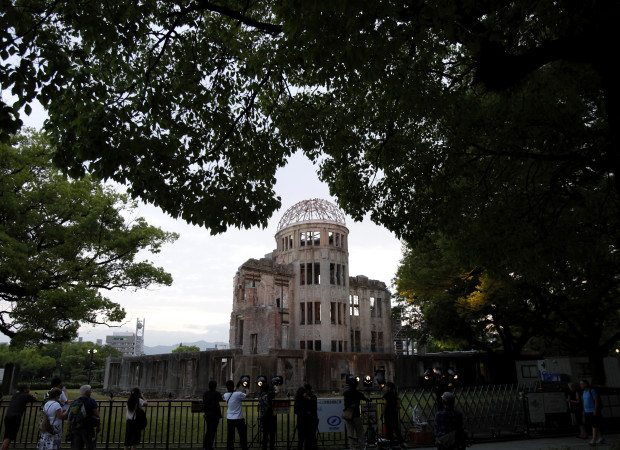
People gather around the gutted Atomic Bomb Dome at the Hiroshima Peace Memorial Park in Hiroshima, southwestern Japan, on May 26. President Barack Obama is to visit Hiroshima on Friday, May 27. AP
HIROSHIMA, Japan—Barack Obama on Friday became the first sitting US president to visit the site of the world’s first atomic bomb attack, bringing global attention both to survivors and to his unfulfilled vision of a world without nuclear weapons.
Obama touched down in Hiroshima after completing talks with world leaders at an international summit in Shima, Japan.
The visit presents a diplomatic tightrope for a US president trying to make history without ripping open old wounds. Obama planned to make a short speech and pay tribute to the 140,000 people killed in the bombing seven decades ago. But the White House has stressed he will not apologize for the attack, which is viewed by many in the US as having hastened the end of World War II; others have called it a war crime that targeted civilians.
The president also is expected to renew his push for a world without nuclear weapons, an aspiration for which he received a Nobel Peace Prize early on his presidency but has since seen uneven progress.
The White House has said Obama will offer a simple reflection, acknowledging the devastating toll of war and coupling it with a message that the world can—and must—do better.
Here, at this place of so much suffering, where US forces dropped the bomb that gave birth to the nuclear age, Obama will also place a wreath at the centopath, an arched monument in Hiroshima’s Peace Memorial Park honoring those killed on Aug. 6, 1945. A second atomic bomb, dropped on Nagasaki three days later, killed 70,000 more.
Obama will also look forward.
Hiroshima is much more than “a reminder of the terrible toll in World War II and the death of innocents across the continents,” Obama said Thursday.
It is a place, he said, “to remind ourselves that the job’s not done in reducing conflict, building institutions of peace and reducing the prospect of nuclear war in the future.”
Those who come to ground zero at Hiroshima speak of its emotional impact, of the searing imagery of the exposed steel beams on the iconic A-bomb dome. The skeletal remains of the exhibition hall have become an international symbol of peace and a place for prayer.
The president is accompanied on his visit by Japanese Prime Minister Shinzo Abe — a demonstration of the friendship that exists between the only nation ever to use an atomic bomb and the only nation ever to have suffered from one.
Bomb survivor Kinuyo Ikegami, 82, paid her own respects at the cenotaph on Friday morning, well before Obama arrived, lighting incense and chanting a prayer.
Tears ran down her face as she described the immediate aftermath of the bomb.
“I could hear schoolchildren screaming: ‘Help me! Help me!'” she said. “It was too pitiful, too horrible. Even now it fills me with emotion.”
Han Jeong-soon, the 58-year-old daughter of a Korean survivor, was also at the park Friday.
“The suffering, such as illness, gets carried on over the generations—that is what I want President Obama to know,” she said. “I want him to understand our sufferings.”
Obama’s visit is a moment 71 years in the making. Other American presidents considered coming, but the politics were still too sensitive, the emotions too raw. Jimmy Carter visited as a former president in 1984.
Even now, when polls find 70 percent of the Japanese support Obama’s decision to come to Hiroshima, Obama’s visit is fraught.
His choreographed visit will be parsed by people with many agendas.
There are political foes at home who are ready to seize on any hint of an unwelcome expression of regret.
There are Koreans who want to hear the president acknowledge the estimated 20,000-40,000 of their citizens who were among the dead in Hiroshima and Nagasaki.
There are blast survivors who want Obama to listen to their stories, to see their scars—physical and otherwise.
There are activists looking for a pledge of new, concrete steps to rid the world of nuclear weapons.
There are American former POWs who want the president to fault Japan for starting the war in the Pacific.
Obama will try to navigate those shoals by saying less, not more.
The dropping of the bomb, he said Thursday, “was an inflection point in modern history. It is something that all of us have had to deal with in one way or another.”
RELATED VIDEO